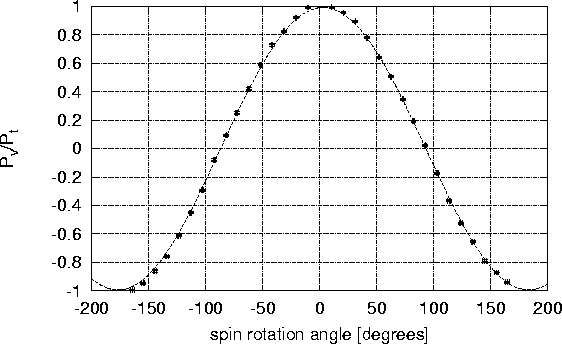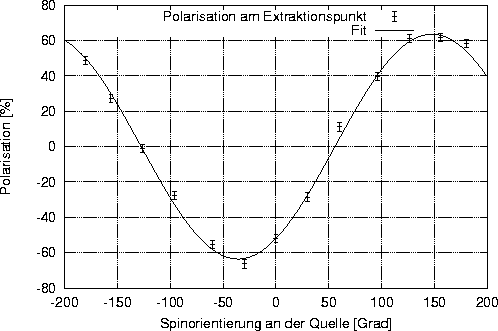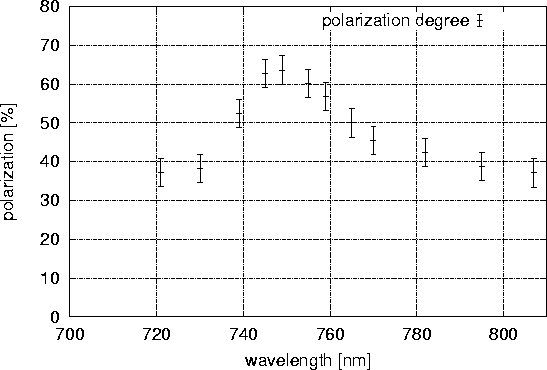
Last update of this page: 08.10.1999
 |
Last update of this page: 08.10.1999 The Sources of Polarized Electrons at ELSADiese Seite auf deutsch |

Some upgrade procedures to improve the intensity and lifetime of the source are on the way and first tests with a superlattice crystal (that provides a higher polarization degree) have started in April 1997. As a result, the polarization could be increased from about 30% with the former bulk GaAs crystal to about 66% with the superlattice one.
After electrostatic acceleration up to 120 keV the electron beam is deflected by about 90 degree by means of an electrostatic field (120 keV => v/c=0.58) to change the initial longitudinal polarization with respect to the momentum of the electrons to transverse. A transverse polarization is necessary to preserve the degree of polarization during acceleration in the booster synchrotron and in ELSA. On the other hand the transverse polarization enables one to measure the electron polarization at 120 keV by Mott scattering.

The influence on the polarization vector by longitudinal fields in the linac lenses is compensated with help of solenoids upstream the linac. The optimum transverse polarization (perpendicular to the synchrotron plane) was adjusted by changing the current through the solenoid and measuring the electron polarization at high energy in the extraction beam line with Møller-scattering.

Earlier measurements
had shown only a small electron depolarization
in the booster synchrotron below the third imperfection resonance (1.32 GeV).
If the transfer energy between synchrotron and ELSA is kept
below this energy no correction elements for the synchrotron are necessary.
In ELSA the behaviour of the polarization during post acceleration has to
be investigated. Calculations and first measurements show that some of
the possible intrinsic resonances (at 2.0, 2.9 and 3.3 GeV) are strong and
have to be corrected in any case.
For this purpose a scheme with two pulsed quadrupoles has been designed.
The required hardware (two Panofsky-type quadrupoles built of ferrites and
the power supplies) has been manufactured, installed and tested. First
calibration measurements were done with beam.
An existing set of correction dipoles, used for closed orbit corrections,
can be used for compensating the depolarizing effects which
occur from the imperfection resonances (by forcing a spinflip at the resonance
at 1.32). For higher energies this scheme is not applicable due to
the strong synchrotron motion of the electrons and the influence of synchrotron
radiation on the spinflip. Therefore for the imperfection resonances above 2
GeV a harmonic correction will be used. For this purpose the existing
corrector system has been upgraded (new power supplies and new control
electronics).
In 1997 first intensive studies of resonance crossing and correction of
depolarizing resonances have been carried out. More
details can be found in a NIM article (Nucl. Instr. and Meth. A 411 (1998)
93-106).
A long running time of the source without maintenance
depends mainly on the lifetime of the flashlamps of the laser (more than
20 million pulses at 50 Hz repetition rate are possible) and an excellent
vacuum in the crystal region. To obtain a vacuum better than 1e-11 mbar
in addition to the ion getter pumps also non evaporable getter (NEG) pumps
are used. At present investigations are made to improve the lifetime of
the source further (at the moment the lifetime is about 50 hours
(with beam) and afterwards one has to re-cesiate the crystal, which takes
about one hour).
Depolarizing Resonances
During acceleration in the synchrotron and in ELSA at certain energies
resonances are crossed which reduce the polarization degree of the
electrons.
Two types of resonances are important, the so called imperfection resonances
due to vertical closed orbit distortions
(independent of the special design of the machine every 440.65 MeV) and
the intrinsic resonances which are related to vertical betatron oscillations.
Performance of the Source
The transfer efficiency from the thermionic gun to the target at high
energy is low at the moment. The main losses occurr in the old
preaccelerators, especially at the injection into the booster. Therefore
an intensity of the order of more than 50 mA in a pulse of 1 musec
is necessary to achieve a continuous electron beam of sufficient intensity
(about 1 nA) at the target. Up to now 100 mA at the source have
been obtained. Improvements
To achieve a higher electron polarization than the theoretical limit of
50% (30% is the limit for real sources) with bulk GaAs respectively GaAsP
these so far used crystals have been replaced n January 1997 by a
superlattice structure (also a strained crystal would be possible) and the
same Ti:sapphire laser can be used. This lead to an increase of the
electron polarization up to 66% at the source.

A second source of polarized electrons has been constructed and has been delievered its first beam at the beginning of 2000. It is placed in front of a new LINAC and operates with a lower electron energy of 50 keV. It is equipped with a mini-loadlock system to provide better lifetimes of the source.
Because of a more advanced design of the cathode area, the new LINAC, a new transfer line to the booster and upgrades to the injection into the booster, the transfer efficiency of this source is be superior to the 120 keV source. With the new source a beam current of more than 3 nA and a polarization of max. 70 % were reached at the GDH experiment